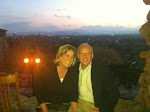Now Moses used to take a tent and pitch it outside the camp some distance away, calling it the “tent of meeting.” Anyone inquiring of the Lord would go to the tent of meeting outside the camp” (Exodus 33:7).
Whenever the people of God broke camp to wander yet a few steps more in the wilderness, the ritual would have to be repeated. How many times did Moses unpack the bundled fabric and throw it over his shoulder, carrying poles under one arm, making his trek away from the clutter and chaos of the encampment; how long did it take to build the frame that gave shape to the tent; how hard was it to drive stakes deep enough into the desert ground so that the structure would stay upright? Tents are hard work, but those simple shelters have often been the site of something sacred.
When my dad was in college he and his brother Earl held a month long tent revival in Emporia, Virginia. They secured a tent from a Pentecostal preacher who had decided he’d had enough of the tent revival business. They set it up and started holding services. During that particular August two hurricanes hit the east coast, making it necessary for the preachers to sew and patch the tent, raise it once more, and empty the upright piano of several gallons of rainwater.
Tents are hard work, but the labor is worth it when God shows up. My dad tells me that during that month-long revival there were more than a few people who came to faith in Jesus. There were some souls for whom that tent was truly a “tent of meeting.” Maybe that’s what kept Moses diligent in pitching his tent. God showed up and met him there.
We can pray anytime in any place, we’re told. It’s true. After all, Moses pitched his tent in more than one place. But maybe there’s something to be said for identifying a sacred space in our lives, a place where we go to meet with God. These days church sanctuaries are about as close as most people come to a sacred space. But Moses pitching his tent suggests something more than a formal worship setting. Nahum Sarna observes that the Hebrew verb used for “pitch” is a word that connotes personal use. We need a tent, as it were. Jesus gave us a similar image in his Sermon on the Mount when he spoke of entering the prayer “closet.”
With the lives we live and the schedules we keep, pitching a tent isn’t easy. It’s as labor intensive for us as it was for Moses. Prayer requires some preparation, intentionality. Haphazard utterances won’t sustain a life of faith, at least not one of depth. Whatever your tent looks like, learn a couple of things from Moses.
First, he pitched the tent “some distance” away from the camp. A life of prayer needs some distance from the noise and banter that dominates our waking hours. Prayer needs the kind of stillness that allows your pulse to slow just a little.
Second, the people who needed to inquire of the Lord came to the tent. Prayer isn’t escapist; it’s not a way to ditch tiring people and their exhausting demands. Though pitched at some distance from the camp, the camp finds its way to the place of prayer. Prayer brings the needs and struggles and anxieties of real life before God.
What would it take for you to pitch a tent – far enough from the clutter of your life, but close enough to bring every part of that clutter before God? Where is your sacred space?
Prayer:
We give you thanks, Lord, for the many different ways in which you meet us. You find us in offices and airports, in parks and malls. Help us in our efforts to find you; help us to create a sacred space where we enter your presence and bring our lives before you. Give us grace that we might be willing to prepare ourselves to listen in obedient faith. Amen.
Tuesday, February 05, 2008
Subscribe to:
Post Comments (Atom)

No comments:
Post a Comment